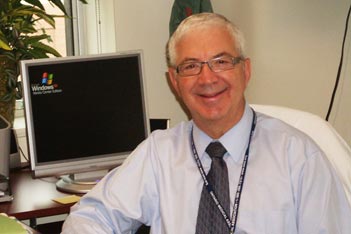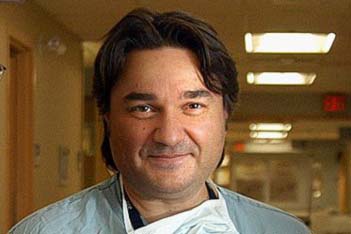Clinical Navigators and a Hotline: The Systems Approach to Thoracic Surgery in the Community
 Robert Zeldin |
Rob Zeldin has developed a remarkable network of partner
institutions as he builds up the thoracic surgery division
at Toronto East General Hospital (TEGH). Working
with Carmine Simone and Simon Iu, he is developing a
Level 1 Thoracic Surgery Centre at TEGH with affiliations
at Sunnybrook, North York General, and the Royal
Victoria Hospital (RVH) in Barrie. As the Section Chair
for Thoracic Surgery at the Ontario Medical Association,
Rob has been able to participate actively in the regionalization
of the specialty throughout the province.
There is some active rearrangement going on as the
LIHN (Local Integrated Health Network) boundaries
don't match the referral patterns. Rob and his partners
won the contract for the North Simcoe Muskoka LIHN
centered around Barrie. They conduct one thoracic clinic
per week in Barrie and admit the patients to Toronto
East General for their procedures. Under the direction of
the TEGH Thoracic Surgeons, a nurse practitioner interviews,
examines and orders appropriate tests on patients
who present to the Barrie site. The TEGH surgeons
rotate through the weekly clinics at Barrie, Sunnybrook
and their own hospital. In-patients and Emergency
Room consults at Sunnybrook are covered by residents
on the Acute Care Service. The trauma surgeons cover
thoracic trauma very efficiently.
There is seamless computer access to the records within
the thoracic service including its partner institutions.
The Ministry of Health and Cancer Care Ontario are
enthused by the partnership model that Rob and his
colleagues have developed and hope it can be duplicated
for other high intensity surgical services such as hepatobiliary
surgery. The anesthesia department currently
rotates its PGY5 residents to Toronto East General for
experience in basic thoracic anesthesia. The thoracic unit
has one senior and two junior general surgery residents
assigned. The unit performs one day endoscopy and 4-5
major cases per week, 20 esophagectomies per year, and a
large number of video-assisted thoracic procedures. All of
the surgeons perform minimum access lobectomies. The
collegiality of the practice is a source of great satisfaction,
and the experience of the general surgery residents on the
thoracic service serves as a focus for recruiting residents
into thoracic training.
|
Carmine Simone serves as Director of the Intensive Care
Unit in addition to his thoracic surgery responsibilities.
He has a great five person unit, all part of the University
of Toronto critical care training program. The unit
consistently ranks as one the most popular rotations for
junior general surgery residents and critical care fellows
and has won awards.
 Carmine Simone |
The thoracic surgery unit has won accolades for its
"Time to Treat" lung cancer program. It became evident
that the waiting time from first suspicion of lung cancer
to a treatment decision was as long as three months. Wait
number one began in the general practitioners' office
and generally included X-rays, CT scans, endoscopy and
other studies. Wait number 2 came from the time of the
decision to treat until the patient got to the operating
room. The thoracic surgeons set up a hotline with clear
instructions to referring doctors, guaranteeing that their
patients would be seen within three business days. The
access program included respirologists as well as surgeons,
and clear guidelines were provided. For example,
cough led to a referral to a respirologist, hemoptysis
is referred to a surgeon. The wait time dropped from
three months to less than one month for a complete
work up and start of treatment. A key component of the
program is the training role of the Clinical Navigators,
Larissa Maxwell in Toronto and Candy Carnahan in
Barrie. A 430 patient study on which this program is
based was described by Dorothy Lo and Rob Zeldin in
the November 2007 Journal of Thoracic Oncology(1).
The success of this program has led to a province-wide
guideline to be published in the fall of 2010 by Cancer
Care Ontario. It will assist referring primary care physicians
in triaging suspected lung cancer patients to the
appropriate specialist.
(1) Lo, Dorothy S. MD ; Zeldin, Robert A. MD; Skrastins,
Roland MD; Fraser, Ian M. MD; Newman, Harold MD;
Monavvari, Alan MD; Ung, Yee C. MD; Joseph, Harry
MBA; Downton, Teresa; Maxwell, Larissa; Meharchand,
Jacinta MD. Time to Treat: A System Redesign Focusing
on Decreasing the Time from Suspicion of Lung Cancer
to Diagnosis. Journal of Thoracic Oncology. 2007; 2 (11):
1001-1006
M.M.
|